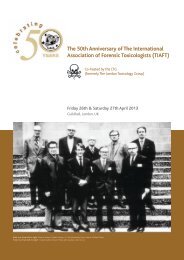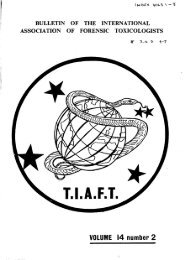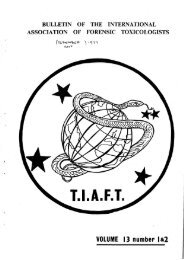Volume XLI Number 1.pdf - The International Association of Forensic ...
Volume XLI Number 1.pdf - The International Association of Forensic ...
Volume XLI Number 1.pdf - The International Association of Forensic ...
Create successful ePaper yourself
Turn your PDF publications into a flip-book with our unique Google optimized e-Paper software.
TIAFT BULLETIN VOLUME 41, 2011. No 1<br />
Page 28<br />
Guidelines for<br />
Young Scientists<br />
Committee Awards<br />
<strong>The</strong> TIAFT Young Scientist Committee has recently updated<br />
the guidelines for the Young Scientist Committee Awards to<br />
provide a fairer scientific evaluation <strong>of</strong> submitted abstracts<br />
and papers. Please find the most recent guidelines below<br />
with changes highlighted in red.<br />
Eligibility for TIAFT YSC Awards<br />
To be eligible for any <strong>of</strong> the 3 prizes:<br />
1. <strong>The</strong> candidate must be the first author <strong>of</strong> the<br />
oral/poster abstract or the scientific paper;<br />
2. <strong>The</strong> candidate, or one <strong>of</strong> his/her coauthors,<br />
must be a TIAFT member;<br />
3. <strong>The</strong> candidate must not be a<br />
member <strong>of</strong> the TIAFT YSC;<br />
4. Candidates working in the same organization<br />
as a TIAFT YSC member are eligible;<br />
5. For the oral/poster abstract, the candidate<br />
must not be older than 40 years on<br />
the last day <strong>of</strong> the TIAFT meeting;<br />
6. For the best scientific paper, the candidate<br />
must not be older than 40 years on the 1st Jan<br />
<strong>of</strong> the corresponding year, and the article<br />
must have been published in the period <strong>of</strong><br />
one month before the last TIAFT meeting until<br />
the deadline for the entries <strong>of</strong> the current<br />
TIAFT meeting, with the condition that the<br />
paper needs to be at least e-published and<br />
available to the scientific community;<br />
7. Only one entry is allowed per applicant. <strong>The</strong><br />
applicant must choose either a poster, oral, or<br />
published paper for consideration. Only one<br />
choice is allowed to allow for the awards to be<br />
shared amongst all qualified young scientists.<br />
8. Oral, poster, or paper presentations that include<br />
a member <strong>of</strong> the TIAFT YSC as a co-author may<br />
still be submitted for consideration <strong>of</strong> an award;<br />
however, the co-author that is a TIAFT YSC<br />
member will be excluded from judging that entry.<br />
9. <strong>The</strong> candidate must submit his/her abstract or<br />
manuscript to the YSC at least one month prior to<br />
the commencement <strong>of</strong> the annual TIAFT meeting.<br />
10. <strong>The</strong> candidate must not be a TIAFT YSC<br />
award recipient from a previous year.<br />
1. Oral Presentations<br />
Abstracts for the best oral presentation must be submitted to<br />
the TIAFT YSC President Dr. Frank Peters (Frank.Peters@med.<br />
uni-jena.de) and Secretary Ms. Madeline Montgomery<br />
(Madeline.Montgomery@ic.fbi.gov) by email.<br />
All submissions must be received by the TIAFT YSC one month<br />
prior to the commencement <strong>of</strong> the annual TIAFT meeting. This<br />
gives the committee enough time to collate and distribute the<br />
submissions to other TIAFT YSC members for consideration.<br />
Once you have received confirmation from the<br />
organizing committee <strong>of</strong> the annual TIAFT meeting that<br />
your oral presentation has been accepted, you should<br />
immediately submit your abstract to the TIAFT YSC. <strong>The</strong><br />
abstract submitted to the TIAFT YSC must not differ from<br />
the abstract accepted for the meeting or it will be subject<br />
to disqualification. Late entries will not be accepted.<br />
<strong>The</strong> YSC will consider a total <strong>of</strong> 15 candidates for oral<br />
presentations each year. In the event that more than 15<br />
abstracts for oral presentations are received in a given<br />
year, the YSC committee will review all abstracts and<br />
evaluate them for the following:<br />
1. Scientific content (Score <strong>of</strong> 1-5)<br />
2. Impact <strong>of</strong> the work on the field <strong>of</strong><br />
forensic toxicology (Score <strong>of</strong> 1-3)<br />
3. Clarity (Score <strong>of</strong> 1-2)<br />
<strong>The</strong> scores from each TIAFT YSC member will be tallied for<br />
all abstracts. <strong>The</strong> 15 abstracts with the highest scores will<br />
be chosen as candidates for the oral presentation award.<br />
All young scientists who have submitted an abstract for<br />
an oral presentation will be notified if their abstract is one<br />
<strong>of</strong> the 15 being considered for the YS oral presentation<br />
award before the start <strong>of</strong> the annual TIAFT meeting.<br />
All oral presentations that are being considered for<br />
consideration for the award will be announced by the<br />
moderator <strong>of</strong> the session prior to the actual presentation.<br />
This enables the audience to be informed that the upcoming<br />
presentation is to be assessed by the TIAFT YSC for Best Oral<br />
Presentation.<br />
2. Award Assessment Criteria<br />
- Oral Presentation<br />
<strong>The</strong> award for best oral presentation is based on a number<br />
<strong>of</strong> criteria and scored in each <strong>of</strong> the following categories:<br />
1. Knowledge <strong>of</strong> subject material (i.e., Did<br />
the presenter include relevant information?<br />
Did they demonstrate an understanding<br />
<strong>of</strong> the topic? Did the author demonstrate<br />
advanced understanding or include any<br />
original scientific content/approach?)<br />
2. Structure <strong>of</strong> presentation (i.e., Was there a logical<br />
structure to the presentation? Could the sequence<br />
<strong>of</strong> information and ideas be easily followed?)<br />
3. Use <strong>of</strong> audio/visual material (i.e., Was audio/<br />
visual material appropriately used? Were<br />
presentation slides high quality and legible?)<br />
4. Pace and timing, delivery style (i.e., Did<br />
the candidate keep to the agreed time<br />
limit? Was the delivery well-paced? Did<br />
the young scientist speak clearly?)







